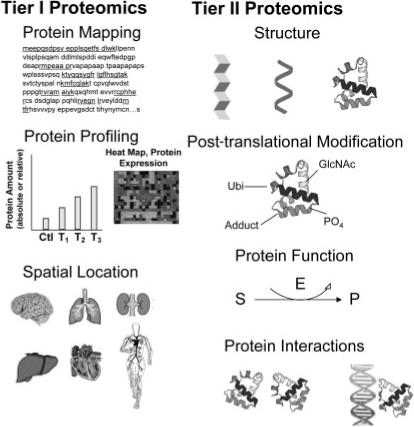Figure 1.

Disciplines of toxicoproteomics to study effects of drug, chemical, disease or environmental stressor exposure. Proteomic analysis attempts to describe various protein attributes in a global manner. Tier I Proteomic Analysis involves protein mapping or profiling. Protein mapping for identification reflects the property of primary amino acid sequence; quantitations of all proteins from a defined space are inherent in Protein Profiling; and isolation or enrichment of proteins from a particular spatial location within cells or tissues help characterize the organism's phenotype. Tier II Proteomic Analysis involves global determination of individual protein attributes (behaviour and structure) regarding their three-dimensional structures, PTMs, functional capabilities and interactions and complexation with other biomolecules. Further explanations follow. In Protein Mapping, the underlined portions of an individual protein represent tryptic peptides for amino acid sequencing for identification by MALDI or MS/MS. In Protein Profiling, changing levels of individual proteins (bar graph) I or groups of proteins (cluster analysis) are measured over treatment (T1, T2, T3) or time. A proteome of interest occupies a specific spatial location for analysis and may comprise a subcellular organelle, tissue or organ. Protein structure may represent the β-pleated sheet or α-helix to form tertiary or quaternary protein folding. Specific post-translational moieties such as ubiquitin (Ubi), phosphorylation (PO4), glycosylation (ClcNAc), chemical adduct or many others are covalently bound to specific amino acid residues on the protein that impart important functional and biophysical properties. Protein Function may be: enzymatic such as enzymatic (E) conversion of substrate (S) to product (P); structural providing form and shape; translocational across cells or tissues; signalling and transduction; or many other utilities to be carried out within cells and tissues. Protein interactions may occur between other proteins, between DNA and proteins, or between other biomolecules.
